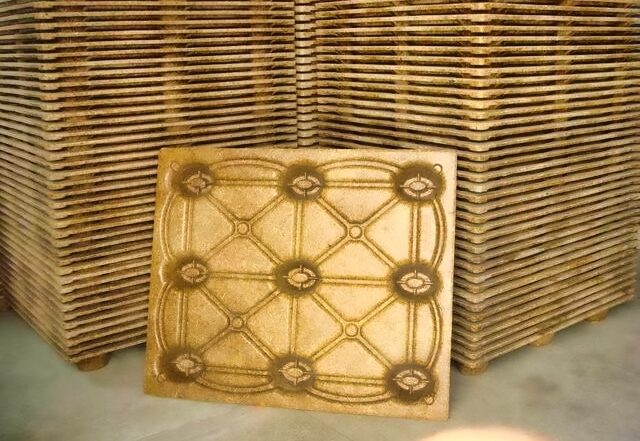
What are the machinery requirements, horsepower specifications, and raw material details for manufacturing compressed wood pallets?
To manufacture compressed wood pallets using a 1000-ton and 1300-ton press, the process involves several machines and systems. Here’s the breakdown:

🔧 Process and Machine Details
1. Raw Material Preparation
🌳 Raw Materials:
- Wood chips, sawdust, wood shavings, or agricultural residues (e.g., rice husk, bagasse) 🌾.
- Size: ≤ 10 mm 📏.
- Moisture Content: 8-12% 💧.
🛠️ Machines:
- Drum Chipper 🌲
- Purpose: Cuts wood logs into uniform chips.
- Horsepower: ⚡ 100-200 HP.
- Hammer Mill 🔨
- Purpose: Reduces wood chips into finer particles (≤ 5-10 mm).
- Horsepower: ⚡ 75-150 HP.
- Dryer (Flash or Rotary) 🌬️
- Purpose: Reduces moisture content to 8-12%.
- Horsepower: ⚡ 50-150 HP.
2. Material Mixing
🧪 Glue/Mixing Machine:
- Purpose: Mixes wood particles with 8-12 % binding agents like urea-formaldehyde resin or phenolic resin.
- Horsepower: ⚡ 15-25 HP.
3. Compression and Pallet Molding
⚙️ Machines:
- Hydraulic Press (1000-ton or 1300-ton) 🏗️
- Purpose: Compresses material into pallet molds.
- Horsepower: ⚡ 75-200 HP.
- Heating System for Mold Plates 🔥
- Purpose: Heats molds to cure and harden resin.
- Power: ⚡ 100-200 kW.
4. Finished Product Handling
📦 Machines:
- Cooling Conveyor ❄️
- Purpose: Cools molded pallets after compression.
- Horsepower: ⚡ 5-10 HP.
- Edge Trimming or Polishing Machine (Optional) ✨
- Purpose: Polishes edges for smoothness.
- Horsepower: ⚡ 10-20 HP.
📝 Summary of Machinery and Power Requirements
| Machine | Purpose | Horsepower (HP) ⚡ | Raw Material Size/Details 📏 |
| Drum Chipper | Wood log to wood chips | 100-200 HP | Logs cut into ≤ 25 mm chips |
| Hammer Mill | Fine grinding of wood | 75-150 HP | ≤ 5-10 mm particle size |
| Dryer | Moisture reduction | 50-150 HP | 8-12% moisture content |
| Glue/Mixing Machine | Mixing with resin/binder | 15-25 HP | Evenly mixed raw material |
| Hydraulic Press | Compression molding | 75-200 HP | Material compressed into mold |
| Heating System | Mold heating | 100-200 kW | For curing resin |
| Cooling Conveyor | Cooling molded pallets | 5-10 HP | Final pallet handling |
A compressed wood pallet plant can manufacture a variety of pallet sizes with different load capacities depending on the press capacity, mold design, and raw material composition. Below is a general guide to pallet sizes and their corresponding load capacities:
Standard Pallet Sizes and Load Capacities
| Pallet Size (L x W x H in mm) | Load Capacity (kg) | Applications |
| 1200 x 1000 x 130 | 1000 – 1500 (Static Load) | General storage, export, warehouse logistics |
| 500 – 800 (Dynamic Load) | ||
| 1200 x 800 x 130 | 800 – 1200 (Static Load) | European pallet standard, ideal for EU markets |
| 400 – 700 (Dynamic Load) | ||
| 1100 x 1100 x 130 | 800 – 1000 (Static Load) | Widely used in Asian and Australian industries |
| 400 – 700 (Dynamic Load) | ||
| 1000 x 1000 x 130 | 800 – 1200 (Static Load) | Used in global export and industrial applications |
| 400 – 600 (Dynamic Load) | ||
| 1200 x 1200 x 130 | 1200 – 1800 (Static Load) | Heavy-duty applications like machinery export |
| 600 – 900 (Dynamic Load) | ||
| 1400 x 1200 x 130 | 1500 – 2000 (Static Load) | Large-scale applications, bulk packaging |
| 700 – 1000 (Dynamic Load) | ||
| 800 x 600 x 130 | 600 – 800 (Static Load) | Small goods, lightweight logistics |
| 300 – 500 (Dynamic Load) |
Factors Influencing Pallet Load Capacity
- Compression Force:
- Pallets manufactured using a 1000-ton press are suitable for light-to-medium loads.
- Pallets manufactured using a 1300-ton press have higher density and are ideal for medium-to-heavy loads.
- Raw Material Composition:
- High-density wood particles increase pallet strength and load-bearing capacity.
- Addition of binding agents (e.g., resins) enhances durability.
- Design Features:
- Reinforced Mold Design: Adds structural strength for handling heavier loads.
- Vent Holes: For ventilation and weight reduction without compromising strength.
- Type of Load:
- Static Load: Weight the pallet can bear while stationary.
- Dynamic Load: Weight the pallet can bear while being moved (e.g., on forklifts).
- Moisture Resistance:
- Proper resin usage and curing ensure pallets are resistant to environmental factors like moisture, extending lifespan.
Customization Options
- Nestable Pallets: Save space during transportation and storage.
- Four-Way Entry Design: Allows forklift access from all sides.
- Ventilation Holes: Reduce weight while maintaining strength.
- Fire Retardant Pallets: For industries requiring additional safety standards.

🛠️ Additional Considerations
- 🌡️ Binding Agents: Adhesives like urea-formaldehyde or phenolic resins (8-12% of raw material weight).
- 📊 Output Capacity:
- Depends on Process Setup and Quality.
- 🔄 Automation: Automated feeding, discharging, and stacking systems improve efficiency.
📩 Contact Us for More Information
🏭 Servoday Plants & Equipments Limited
📞 Phone: +91 9427210483 Sanjay Masuria
✉️ Email: sanjay@servoday.in
🌐 Web: www.PelletIndia.com, www.GrabsIndia.com
